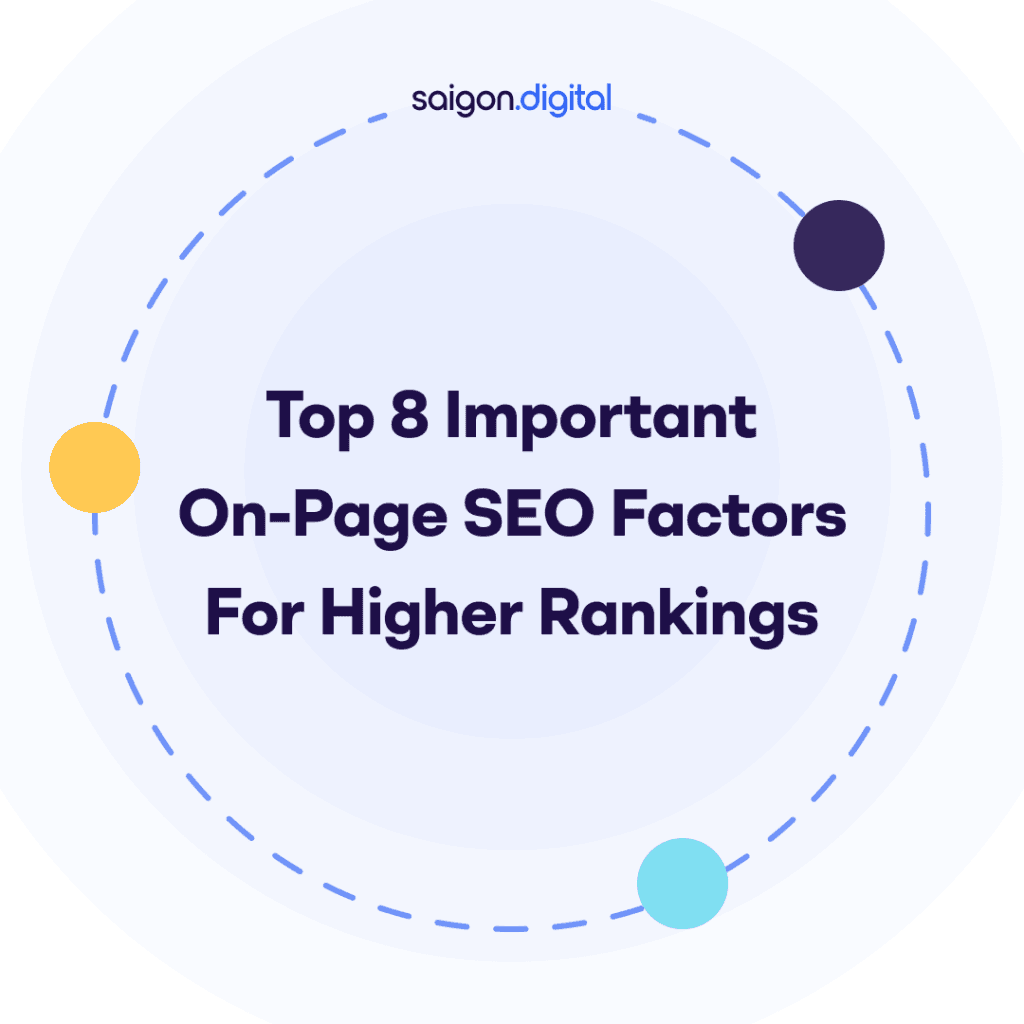When you search for something online, Google considers a variety of factors to decide which websites appear at the top of the results page. These factors, known as on-page SEO, influence how search engines understand and present your website.
By optimising your on-page SEO, you can increase your website's visibility, attract more organic traffic, and ultimately, climb the search engine rankings. Let's explore the most important on-page SEO factors that can help you achieve just that.>> Read more: On-Page SEO Checklist: Optimising Your Content
1. Content is King: The Cornerstone of On-Page SEO
Content is the undisputed king in the realm of on-page SEO. High-quality content that resonates with your target audience forms the bedrock of a successful SEO strategy. Here's what separates exceptional content from the mundane:- User-friendliness: Prioritise clear and concise language. Imagine explaining a complex topic to a friend—that's the tone to strive for. Break down intricate concepts into digestible chunks using bullet points and subheadings for enhanced readability.
- Expertise and Value: Establish yourself as a thought leader in your niche. Conduct thorough research, cite credible sources, and offer insightful analysis. Back up your claims with data and statistics to solidify your authority.
- Depth and Comprehensiveness: Don't provide a mere overview. Dive deep into the topic, addressing user queries comprehensively. Anticipate potential questions your audience might have and provide well-rounded answers.
- Content Freshness: Search engines favour websites that consistently deliver fresh content. Regularly update your existing content with new information and address emerging trends to maintain user engagement and search engine relevance.
2. Keyword Targeting: The Language Search Engines Understand
- Keyword Research: Conduct thorough keyword research to identify search terms with high search volume and low competition. Tools like Google Keyword Planner and SEMrush can be invaluable assets in this process.
- Understanding Search Intent: Don't just focus on keywords; delve deeper into user search intent. What information are users seeking when they type in a particular keyword? Tailor your content to answer user queries and solve their problems directly.
- Strategic Keyword Integration: Weave relevant keywords throughout your content, including titles, headings, meta descriptions, and the body text itself. However, avoid keyword stuffing – prioritise a natural reading experience.
3. Keyword Placement: Strategize, Don’t Spam
Keywords are still king, but where and how you use them matters. Sprinkle your main keyword in these areas:
- Title tag
- First 100 words
- Subheadings
- URL
- Naturally throughout the content
4. Compelling Title Tags: Your First Impression Matters
A title tag is more than just a string of words—it’s your website’s handshake with potential visitors. Think of it as a storefront sign that grabs attention and sets the tone for what lies inside. In the competitive digital world, crafting compelling title tags is a critical on-page SEO factor. Here’s why they matter and how to create irresistible ones.- Keyword Optimization: Include your primary keyword naturally. Search engines use these keywords to determine relevance, so placing them at the beginning of the tag can enhance visibility.
- Conciseness: Keep it under 60 characters to ensure it displays fully in search results. Anything longer might get truncated, cutting off important details.
- Uniqueness: Avoid duplicating title tags across pages. Each tag should reflect the unique value of the corresponding page.
- Actionable Language: Use verbs and power words to engage users. Phrases like “Discover,” “Boost,” or “Learn” create a sense of urgency and interest.
- Clarity and Context: Make your title specific and informative. Users should immediately understand what they’ll gain by clicking on your link.
Tips for Writing Compelling Title Tags:
- Think Like Your Audience: What would make you click on your link? Cater to your target audience's curiosity, problems, or desires.
- Incorporate Numbers or Dates: Numbers stand out in search results and convey specificity. For example, “10 Tips for Better SEO in 2025” is more appealing than “Tips for Better SEO.”
- Use Emotional Triggers: Phrases like “Amazing,” “Proven,” or “Game-Changing” can add a layer of excitement that captures attention.
- A/B Test Variations:
Experiment with different title formats to see which performs best regarding CTR and rankings.
5. Meta Descriptions That Entice Clicks
Meta descriptions might not directly affect your ranking on search engines, but they hold immense power when it comes to influencing click-through rates (CTR). Often, they’re the unsung heroes of SEO—providing a concise summary of your page while persuading users to choose your link over others in the search results.- Include Your Primary Keyword Naturally: Highlighting your focus keyword reinforces relevance and matches user search intent, making your link more enticing.
- Focus on User Intent:
Tailor your meta description to what users are looking for. Are they seeking information, solutions, or products? Speak directly to their needs. - Keep It Concise and Clear: Aim for 120–160 characters to display your description across all devices fully. Conciseness ensures clarity and prevents truncation.
- Use Action-Oriented Language: Encourage action by using verbs like “Learn,” “Discover,” “Explore,” or “Find out.” These phrases make the user feel like they’re taking the first step toward a solution.
- Incorporate Emotional Appeal: Use language that evokes curiosity, urgency, or excitement. For example, “Transform your SEO strategy today with these proven tips” is more engaging than “SEO tips for your website.”
- Make It Unique for Each Page: Avoid duplicating meta descriptions across your site. Each page should have a description tailored to its specific content to improve CTR.
Advanced Tips for Meta Description Optimization
- A/B Testing for CTR: Experiment with different styles, tones, or keywords in your meta descriptions to find what resonates best with your audience.
- Use Structured Data to Complement Descriptions: Rich snippets (like reviews, ratings, or FAQs) can enhance your search result, making your meta description even more effective.
- Leverage Competitive Analysis: Study the meta descriptions of top-ranking pages in your niche. What tone or style do they use? Use this insight to refine your own descriptions.
6. Headings & Subheadings: Structuring for Clarity
Headings and subheadings act as a roadmap for your content, guiding users through your narrative and enhancing readability. Here's how to leverage your on-page SEO with headings effectively:- Hierarchy and Clarity: Maintain a clear hierarchy of headings (H1, H2, H3, etc.). Use H1 for the main title and subsequent headings for subtopics.
- Keyword Integration: Strategically integrate relevant keywords into headings for improved search engine visibility.
- Breaking Down Complexity: Utilise subheadings to break down complex topics into easily digestible sections, making your content more scannable and user-friendly.
7. Internal Linking: Weaving the Web of Your Website
Internal linking involves strategically connecting relevant pages within your website. It fosters a user-friendly experience by allowing users to navigate seamlessly through related content. Additionally, internal linking distributes "link juice," an on-page SEO ranking factor considered by search engines. Here's how to leverage internal linking effectively:- Contextual Relevance: Link only to pages that are topically relevant to the current page. This ensures a smooth user experience and avoids confusing users with irrelevant detours.
- Anchor Text Optimisation: Use descriptive anchor text for your internal links. Instead of generic terms like "click here", employ keywords that accurately reflect the content of the linked page. Strategic keyword integration creates a win-win for users and search engines.
- Strategic Link Placement: Don't just dump links at the bottom of your content. Place them strategically throughout the text, within the natural flow of your writing, to guide users towards relevant information.
8. Images & Multimedia: Enhancing Engagement with Visual Appeal
Images and multimedia elements can significantly enhance user engagement and break up text-heavy content. However, optimising them for on-page SEO is crucial. Here's how to incorporate visuals strategically:- Image Optimisation: Reduce image file sizes to ensure fast loading speeds. Lagging load times can severely hinder user enjoyment and search engine rankings. Thankfully, tools like TinyPNG can streamline image size, minimising the impact.
- Descriptive Alt Text: Include descriptive alt text for your images. This not only improves accessibility for visually impaired users but also helps search engines understand the content of your images.
- Relevance: Ensure images and multimedia elements are directly relevant to your content. Avoid using stock photos that don't add value or relate to the topic.
9. URL Structure: Enhancing User Experience and SEO
URL Structure refers to the format of your website's web addresses. While not a direct on-page SEO ranking factor, a clear and concise URL structure can enhance user experience and indirectly contribute to SEO benefits:- Clarity and Conciseness: Strive for URLs that are easy to understand and reflect the page's content. Avoid overly long or complex URLs.
- Keyword Integration: Strategically include relevant keywords within your URLs, but prioritise readability over keyword stuffing.
- User-friendliness: Opt for a URL structure that is hierarchical and logical, making it easy for users to navigate your website.
10. Technical SEO Considerations: The Underpinnings of a Seamless Experience
While content reigns supreme, a robust technical foundation is equally important for on-page SEO. Here are some key technical considerations:- Website Speed: Prioritise fast loading speeds. Modern web users have little patience for sluggish loading times, which can trigger high bounce rates. Fortunately, resources like Google PageSpeed Insights exist to pinpoint areas for improvement.
- Mobile-Friendliness: In today's mobile-first world, ensuring your website is responsive and delivers an optimal viewing experience across all devices is crucial.
- Structured Data Markup: Consider implementing structured data markup, which provides search engines with additional information about your content, potentially leading to richer search results.
How to Stay Ahead with On-Page SEO
Staying ahead in the ever-evolving world of SEO requires a proactive and adaptive mindset. On-page SEO is not just about initial optimization—it’s a continuous process that demands consistent effort. Here’s how you can maintain and enhance your on-page SEO strategy to stay ahead of the competition:
1. Regular Content Updates
- Why It Matters: Search engines prioritize fresh, relevant, and up-to-date content. Stale or outdated information can lead to lower engagement and rankings.
- How to Implement: Regularly revisit your published pages and blogs to ensure accuracy and relevance. Update statistics, trends, and facts to align your content with current industry standards.
2. Leverage Analytics for Insights
- Why It Matters: Analytics help you understand what's working and what isn’t. They provide data-driven insights into user behaviour, keyword performance, and page engagement.
- How to Implement: Use tools like Google Analytics and Search Console to monitor bounce rate, session duration, and keyword rankings. Identify underperforming pages and optimize them for better results.
3. Keep an Eye on Algorithm Updates
- Why It Matters: Google updates its search algorithm frequently, and staying informed can help you adapt quickly.
- How to Implement: Follow SEO news outlets and Google’s official announcements. Review your site to ensure compliance with new guidelines when an update rolls out.
4. Optimize for Core Web Vitals
- Why It Matters: Google emphasizes user experience metrics like loading speed, interactivity, and visual stability.
- How to Implement: Use tools like Google PageSpeed Insights or GTmetrix to analyze your site’s performance. Address issues such as large images, slow-loading scripts, or unresponsive layouts.
5. Stay Mobile-Friendly
- Why It Matters: With most searches happening on mobile devices, Google prioritizes mobile-first indexing.
- How to Implement: Regularly test your site’s usability with Google’s Mobile-Friendly Test. Optimize layouts, font sizes, and buttons for seamless mobile navigation.
6. Focus on User Intent
- Why It Matters: Search engines now prioritize content that matches the intent behind search queries—whether informational, transactional, or navigational.
- How to Implement: Conduct keyword research to understand user intent. Structure your content to answer questions, solve problems, or provide value directly tied to users' needs.
7. Experiment with Content Formats
- Why It Matters: Search engines favour diverse content types, including videos, infographics, and interactive elements, which boost engagement.
- How to Implement: Mix up your content strategy by incorporating multimedia elements. For example, turn a blog post into a video tutorial or a downloadable infographic.
8. Build an Internal Linking Structure
- Why It Matters: Internal links improve site navigation and help search engines understand your content hierarchy.
- How to Implement: Regularly audit your internal links. Ensure each page is linked to other relevant pages, creating a logical and user-friendly structure.
9. Encourage User Interaction
- Why It Matters: Engaged users are likelier to stay on your site, reducing bounce rates and improving SEO signals.
- How to Implement: Add features like comment sections, polls, and CTAs (call-to-actions) to encourage interaction. The more users engage, the better your content performs.
10. Stay Curious and Keep Learning
- Why It Matters: SEO trends and technologies evolve rapidly, and staying informed is essential to staying competitive.
- How to Implement: Follow SEO blogs, attend webinars, and participate in forums. Continuous learning will help you adapt and refine your on-page SEO strategies effectively.





